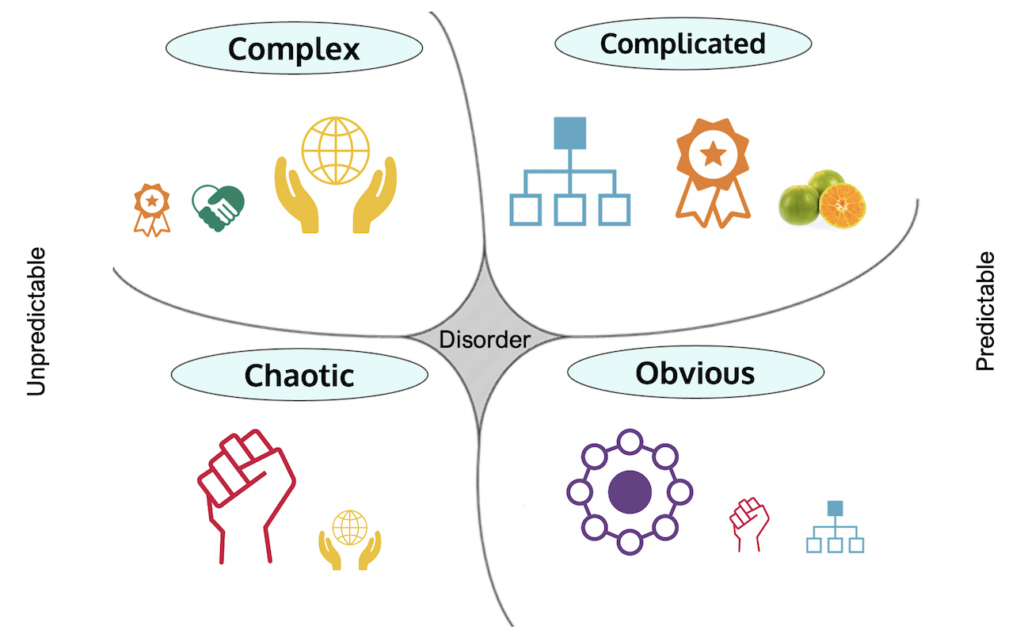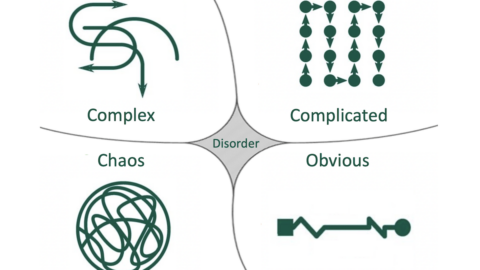This series of two articles explores the fit between the organizational models attributed to the value systems of Spiral Dynamic and each of the five organizational contexts identified by the Cynefin model.
The first article entitled VICA and the organizational contexts of the Cynefin model made the connection between the increasing complexity of organizational contexts, the need for evolution according to Spiral Dynamic and the different contexts proposed by the Cynefin model. In the second article Cynefin and the organizational models of Spiral Dynamic, we explore the detail of the different organizational models that correspond to the value systems of Spiral Dynamic and look at which ones are compatible with each context of the Cynefin model. We also connect the Cynefin model with the second tier value systems of Spiral Dynamic.
This article is intended for an audience that has a basic knowledge of Spiral Dynamics and an understanding that the value systems (purple, red, blue, orange, green and yellow) each correspond to a type of organizational structure.
Organizational models based on Spiral Dynamics value systems
We have already referred to the value systems (or levels of existence) of Spiral Dynamics. We use this approach here to overlay the different types of organizational models that are attached to different value systems of Spiral Dynamics with the organizational contexts of the Cynefin model.

- Obvious + Centralized: while we identified three types of structures and value systems that can function in an “obvious” organizational context, we have chosen to highlight the value system(s) that is most appropriate and most commonly observable for each context. Let’s start with this one:
- The informal structure with a patriarchal type of leadership: the absence of complicated and complex elements in the environment makes this type of organization very functional. Indeed, the person(s) managing these structures often have the experience and skills to make all decisions centrally. A cultural trait of this structure is that the leaders are trusted because they carry on certain traditions of how things are done in a given field. In this context, decisions are perceived as fair and are respected by the employees. This type of structure corresponds to the purple value system.
We want to mention two other value systems that function in this context, even though they don’t seem like a natural and perfect fit:
- The autocratic structure with a strong leader that has all the answers and is followed by people. Similarly to the informal structure, because of the future is predictable, a strong leader with the sufficient intelligence and/or experience can produce achievements that give him·her an almost guru status that people can trust and follow. This type of structure corresponds to the red value system.
- The centralized and hierarchical structure: the environment and external elements are predictable; it is therefore relatively easy for a person to exert the power given by the hierarchy and produce reliable results using the controlled structure of a bureaucracy. What makes this structure particularly fit to an obvious context is that the culture that would develop is that there is a right way and a wrong way of doing things. It would be expected that everybody gets in line and follow the rule of the “right way”, which is the way it is done here and there is no room for debating whether that is appropriate, effective, or efficient. This type of structure typically refers to the blue value system and its formal structure.
- Complicated + Decentralized – let’s start with the two types of structures and value systems are most compatible with in a “complicated” organizational context:
- Bureaucratic structures, which corresponds to the blue value system, were the first to create decentralized structures to adapt to a more complicated context where a centralized structure would no longer be able to manage a growing organization. The first really large organizations (before globalization started in the 1980’s) were either religious organizations, government organizations, NGO’s or large industrial (usually national) companies. All of them were typically structured in pyramidal model, which in its essence is a way of scaling what had worked so far (a centralized structure in the obvious context) and interconnect them vertically with a top-down delegation of power. This type of organizations can work fine if there is no need for innovation and there isn’t much competition, which is typically the case for religious organizations, government, and NGO and most of them still operate with this organizational structure.
- Bureaucratic structures fail in the complicated context when in a competitive environment and there is a need for innovation combined with growing profits by constantly optimizing processes in order to gain efficiency. In this context, result oriented organizations do much better, which corresponds to the orange value system. While remaining hierarchical they are more flexible and typically structure themselves either in the shape of a matrix or by creating a more agile parallel organization constituted of project teams. Most profit-oriented organizations today function in this value system and are constantly pushing the boundaries of competition and constant performance and financial results optimization. The entire world of management as we know it today derives from this world view, which is a mechanistic approach of the company where humans are a basically a resource. This is the weakest part of those organizations and the growing psychosocial issues like burnouts and boreouts are the visible symptom of systems in which humans are under constant pressure to produce more. Of course, most of these organizations are aware of this and see value in focusing more on people, values, and culture – but rarely are they willing to put those before strategy and profitability. They start integrating elements from the green value system into a primarily orange environment.
Now let’s look at another type of organizational context that is appearing more and more in this context:
-
- There are the “Green skinned orange” organizations that are typically green on the outside and orange inside. Notable examples are Ben&Jerry, Southwest Airlines, and Virgin. They do put values, culture and people before profit and are fairly vocal about it. This is one of the components of a green organization, but they don’t have an egalitarian structure where decisions are made by consensus. Instead, they typically function in a hierarchy and managers focus more on enabling people rather than exercising their authority. They typically practice “participative management” where decisions are taken by the manager after an advice process with the team. While the culture is more family oriented where everybody has a role, that typically still requires a charismatic leader who incarnates the organizations’ values and has a patriarchal style: leading the way, crafting the value-based narrative, being the company’s public figure and granting access to the new members joining the family. While the culture of these organizations are shifting and a great source of inspiration for a typical orange organization, their structure usually remain a classic pyramid. In that way, they are not contributing to solving the complicated context better than the other two value systems, but they certainly alleviate some of their undesirable effects (notably dehumanization of employees).
- Complex + Distributed: let’s look at the attempts to evolve in this direction through the lens of the various value systems that are at play. Let’s start with two value systems that try to work in this context although with many limitations:
- In the orange value system, the desire to distribute authority and to call on collective intelligence is achieved either through a matrix organization that allows people to be grouped together in different cross-functional teams in order to exchange best practices within the teams. The other structure that is observed is the multiplication of project teams that often operate in a very informal structure and completely separate from the classic hierarchical organization. Complexity requires a form of action in order to be probing the system and be in the “investigation” phase and then to be able to feel what the system’s response will be. This is rationalized by a culture of innovation in which “trial and error” is celebrated, by pivoting to new strategies (lean startup) or the famous “learning by doing”. The pitfall in using this approach is that there is usually a lack of understanding of what “sensing” is because “analysis” is the default mode of perceiving what the response of a complicated system is (which is the context in which the orange value system excels). The competitive mindset, the calculated behavior, the winner culture and matrix or project-based organizational structure of the orange value system systematically show their limits in a complex context and are not particularly appropriate. However, it should be noted that this value system remains dominant, especially in for-profit organizations.
- In the green value system, the organization may well include a hierarchical component, or even include elements of a decentralized structure, but what characterizes it is that the principle of subsidiarity is more important than that of subordination. By its design and by its natural capacity to sense, the green value system looks like it would be appropriate in a complex context. We already distinguished two different aspects that lead an organization to experience the complex context. One is given by its external environment, and we have described this at length with how VUCA contributes to that. The other is when an organization wishes to move away from a mechanistic vision of its functioning and chooses to put the human being at the center of its concerns (and stop considering humans as a “resource”). This is typical when people in the organization operate from a green value system and make their organization evolve in a way to be more compatible with the individuals. In this type of complexity, a pure green value system driven organization will be adequate and satisfy the context of complexity induced by prioritizing the people in the organization over strategy and results. If the organization however is facing complexity from its external environment, the green value system can also be effective, but only if it is combined with the willingness to experiment and take risk that the orange value system brings to the table (or with the same trait integrated by the yellow value system as “healthy orange”). Without that, a purely green structure risks to fail because of its shadow aspect that is hesitant to act. The pitfall of the green value system in a complex environment is to require consensus from all before being capable to act. And when it comes to sensing the response, again everyone involved would have to agree on how to interpret the response and on what the best course of action is. While functional, this is likely to slow down the learning curve and capacity to produce results. If the context is evolving very fast, this pitfall could provoke the downfall of a structure that is too slow to respond (even if the action that ends up being decided upon was correct, it comes too late to produce the expected result).
Now let’s look at the value system that deals most effectively with this context:
-
- In the yellow value system, the organization distributes leadership and authority and is structured in a completely distributed manner. The organization is self-learning in nature, people and teams are autonomous and self-managed. This type of distributed organization is a characteristic of the yellow value system and is particularly adapted to face the context of complexity. Another characteristic of this value system is its ability to act without being driven from fear. The pitfall of the yellow value system is to add complexity to the situation or communication in such a way that it makes the situation confusing or incomprehensible by others. Whereas the expected ability would be to succeed in simplifying the situation and communication.
- Chaotic: modern organizations rarely find themselves in a state of prolonged chaos unless they are struggling for survival. When this is the case, we would assume that actions oriented towards short-term results and avoiding bankruptcy are driven from the beige value system. While that may be the case in the underlying value system driving these actions, we do not recognize as an “organizational context” as beige operates from the limbic system and is pre-language and conceptual thinking. Let’s look at the main value systems that deals effectively with this context:
- Let’s consider a context of chaos when an organization is going through a crisis or emergency for instance. It is interesting to make the connection between crisis and emergency situations. In the field of emergency care interventions, it has been proven that a directive leadership of the person in charge is what produces the best results. It is of course possible to challenge these decisions afterwards during debriefing, but in action there is no room for debate or difference of opinion. The same thing has been observed in crisis situations. The autocratic mode of operation (which is the characteristic of the red value system) is the one that works best. In the historical context, it is a value system that we tend to reject, because we associate it with power, force, and even dictatorship. One of the main lessons of the Cynefin model is that it is useful to reconcile with this mode of functioning because it is often the last resort of an organization that is going through a chaotic phase. It can even be interesting for a distributed organization to foresee in its governance that the transition to an autocratic mode of functioning is not just tolerated, but desired, in case the organization goes through a chaotic phase.
There is another value system that should be mentioned for this context:
-
- Considering that the yellow value system is the Tier 2 equivalent of the Tier 1 beige survival value system, it can be argued that in large scale survival challenge such as an organization in chaos or humanity as a whole in chaos, the yellow value system’s solutions would be critical for survival. Yellow tends to act from a place of sensing and trust (non-fear) – which you could argue would be needed to respond to large scale chaos – rather than limbic (beige), power (red) or logic and analysis (orange), all of which would certainly be at play if chaos were to reach a larger scale. However, we don’t imply that yellow would not be needed to address the life conditions of a chaotic context.
Disorder
Disorder is not an organizational context per se. Rather, it is the situation in which an organization finds itself when it uses the various strategies, practices, and organizational models to which it is accustomed rather than those appropriate to the context in which it finds itself. This creates tension and dissonance in both the functioning of the organization and how people experience it.
Spiral Dynamics offers a model for how “change” occurs, and the disorder context certainly has a role to play in it. According to Spiral Dynamics, change only occurs when the life conditions evolve, and the prevalent cognitive capacities and actions generate more and more tension with those new life conditions. The context of disorder could indicate that a change is about to happen. There are two types of changes:
- 1st order change which does not necessarily result in a change of value system, but most likely in an evolution of practices withing the same value system that temporarily resolves the tensions.
- 2nd order change which typically leads to a value system change because the situation can’t be solved from the current values system and a transformation to the next value system is needed.
Depending on how an individual or an organization is integrated in its value systems, they would respond to each context from their dominant value system and in either a healthy or unhealthy way.
The context of disorder, experienced from a healthy integration, could lead to a 2nd order value system change. Or if experienced from an unhealthy integration, it could move the individual to act from its stress profile in an unhealthy way.
In the VICA context, it is not uncommon for an organization to be labeled as “problematic,” “dysfunctional,” or even “toxic. This is clearly a symptom of the context of disorder and means that they are deploying strategies and employing models that do not fit the context in which they find themselves. The question is to know what evolution is possible from this observation and if a 2nd order change is possible or not.
Where does the green organizational model shine?

The previous illustration illustrates which value systems are most appropriate to deal with each of the contexts: purple in the simple context, blue and orange in the complicated context, yellow in the complex context and red in the chaotic context. Interestingly, green isn’t coming out as a great match for neither the complicated nor the complex contexts. Did we miss something? What context would green be most effective in?
For sure the green organizational model has more affinity with the upper part of the model where the organization is either decentralized or distributed. We pointed to the limitations that green has when dealing with a complex context, mainly its difficulty to act without reaching a consensus first. And maybe we haven’t highlighted enough how fundamental some of the green elements are when dealing with a complex context, such as the capacity to sense and to put the human beings at the center of the organization. But given its limitations, a yellow organizational model will thrive in a complex context while using those elements taken from green as a foundation to build upon.
Can a green organizational model shine in a complicated environment? In theory YES, but we live in a world where the orange value system is so dominant in almost all complicated contexts that it’s difficult to find real life example of purely green culture or organizational structures in a complicated context, hence the metaphor of the green oranges that we used to illustrate the role green is currently playing in larger corporations. And there are of course exceptions to this. First there are some non-profit organizations that operate from a green value system. And in the economy, we see some purely “for purpose” organizations such as Buurtzorg and Patagonia. But with these types of organizations, it’s not easy to distinguish how much of their culture or structure is driven from the green or from the yellow value systems.
A large part of the economy operates in the complicated context based on blue-orange structures. Our global “life conditions” are evolving rather rapidly to the context of complexity where yellow would strive most, it might be fair to highlight that this evolution can’t happen without first fully embracing the green value system. It is important to emphasize that this evolution cannot occur without a total adherence to the green value system. From this perspective, the green value system has a major role to play in paving a bridge between the two contexts on the top of the Cynefin model and showing a pathway for an evolution
The Cynefin model and the 2nd tier value systems
The nature of the Cynefin model is a perfect illustration of the yellow value system of Spiral Dynamics. The model proposes to look at every context and find what works best in this environment rather than applying a one-size-fits-all approach to the way cause-and-effect works, practices get determined, problems get solved or organizations get structured.
This is exactly the capacity that the yellow value system brings forth, being the first value system of the 2nd tier. The characteristic of 2nd tier is to have integrated, accepted and be capable to operate in each and every one of the value systems of the 1st tier (beige, purple, red, blue, orange and green).
Another characteristic of the yellow value system is to be able to integrate complexity and to have a systemic approach. The left side of the Cynefin model represents unpredictable contexts, applying 2nd tier mindset to those produces some interesting shifts:
- The Complex context is the one that has a natural match with yellow. Having an understanding for what complexity is, that it’s just another context that needs different ways of thinking and solving problems is a refreshing approach compared to the prevalent attempts to apply mindsets and tools from the complicated context in complex situations.
- The Chaos context seems to call for the red value system to sort out the crisis situation. However, if we are looking at chaos as a situational context (the view from yellow and 2nd tier), it’s a very different angle than looking at same situation when red is the dominant mindset at hand. With the yellow value system being a second-tier system, it incorporates and transcends the first-tier systems, hence people operating from the yellow value system would be able to draw on typical red value system actions when needed (but motivated from the yellow value system in chaos situations). They would not take decisive and autocratic actions for their own power gain, rather aiming at the perspective of stabilizing the whole system. From that angle, chaos and crisis, are simply unpredictable phenomenon that tend to emerge in a complex and unpredictable context. The model recognizes this as a separate context because different methods than those used in the context of complexity are required, for example “do what is needed to get the desired result and re-establish a functioning environment”.
Caveat about combining the two models
This entire analysis was made with the sole purpose to look at which organizational structure is more appropriate in the different contexts of the Cynefin model. If we were to look at combining the two models in a broader way than the contexts of organizations, we could take a completely different angle to explore a possible combination of the models. For example, individuals operating in different Spiral Dynamics value systems could be experiencing life conditions in which all five contexts could be present in each value system.
There is no reason why a person operating from a healthy red value system would not be able to function in the chaotic context or complex context. For example, firefighters rescuing people from the burning building can be operating from the red value system, saving lives even if they do it to be seen as the heroes saving the day.
Another example is that of an individual driven by the red values system who want to profit from the refugees. They could contribute in a meaningful way to provide safety to those refugees, even if it is through charging a fee to an organization (operating from the green values system) and renting them a place from where to operate their shelters. It might be judged harshly, but it is positively contributing to solving a complex or chaotic problem.
In video (ValueMatch conference)
Here is a recording of a conference presenting this material in November 2022.
Resources and suggested reading
- The Cynefin Framework by Snowden, D. and Boon, M. “A Leader’s Framework for Decision Making”, Harvard Business Review, November 2007
- Complicated or Complex? by Carmen Medina, January 2022
- Understanding Complexity by Erwin van der Koogh, July 2019
- Spiral Dynamics Integral (audiobook) written and read by Dr. Don Beck
- Spiral Dynamics in Action: Humanity’s Master Code by Dr. Don Beck, Teddy Hebo Larsen, Sergey Solonin, Dr. Rica Viljoen, Thomas Q. Johns
- La spirale dynamique – Comprendre comment les hommes s’organisent et pourquoi ils changent by Fabien Chabreuil and Patricia Chabreuil
- ValueMatch offers a free Spiral Dynamics knowledge test, as well as a values report and a personal change report (for a fee)








